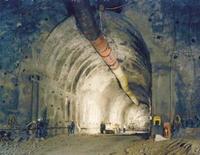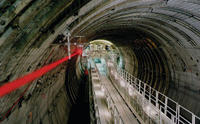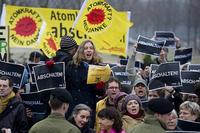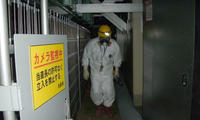-
Obama official says Yucca Mountain nuclear storage site has no chance

On Monday a senior Department of Energy official said that the long-term nuclear storage facility in Yucca Mountain, Nevada was no longer a viable option; Daniel Poneman, the deputy Energy Secretary, said, “We do not see Yucca Mountain as a solution here. It is time to turn the page and try to find a better set of solutions”; in 2002 Congress approved Yucca Mountain as the designated long term storage site for nuclear waste from atomic reactors in the United States and preparations were under way for the deep underground facility, but in 2010 President Obama withdrew funding for the project
-
-
Nebraska nuclear plant on flood alert
Levees in northern Missouri were failing late Saturday and Sunday as a result of massive release of water from upstream dams; farmland and houses in two Missouri counties — Holt and Atchison — were flooded and residents evacuated; two Nebraska nuclear power plant place on flood alerts
-
-
"Melt-through" at Fukushima nuclear plant
Japan has admitted that molten nuclear fuel in three reactors at the Fukushima Daiichi power plant has burned through pressure vessels, not just the reactors’ cores — creating a “melt-through,” which is a more serious problem than a melt down
-
-
Grids complicate Germany’s nuke exit
Chancellor Angela Merkel faces a daunting challenge as her cabinet must implement a plan that replaces 23 percent of the nation’s energy output as nuclear power plants are phased out; to successfully end its nuclear energy program with minimal disruptions, Germany must first build a $14.4 billion expansion of its electrical grid; electrical cables are needed to bring energy generated from offshore wind farms in the north to its manufacturing centers in the south; in addition, high-volume lines stretching to France must be built to allow for energy imports to cover any shortfalls; but Germans have long been opposed the building of new overhead power lines; the country must construct as much as 2,235 miles of cables by 2020
-
-
Iran pushes ahead with nuke plans, despite seismic warnings
Iranian officials have chosen to ignore the warnings of top scientists and continue with the construction of nuclear facilities near earthquake prone regions; according to an official with the International Atomic Energy Agency, in a top level meeting Iran’s leaders recently decided to move ahead with plans to construct nuclear facilities, despite Iranian scientists’ warnings that “data collected since the year 2000 shows the incontrovertible risks of establishing nuclear sites in the proximity of fault lines’ in Khuzestan as well as nineteen other Iranian provinces; Iran is one of the most seismically active countries in the world with major fault lines covering at least 90 percent of it
-
-
Glimmer of hope for Yucca Mountain nuclear waste repository project

Over the last twenty-five years, the United States has spent around $15 billion on the Yucca Mountain Nuclear Waste Repository which was supposed to offer a solution to the growing nuclear waste problems at U.S. nuclear power plants; in what some charged was a political move by President Barack Obama to secure Nevada’s Democratic tilt, the administration defunded the project, and funding for work on the site was terminated altogether effective with the 2011 federal budget passed by Congress on 14 April 2011; some in Congress want the project to continue, and the House Appropriations Committee has added $35 million for the project in the 2012 energy spending bill; this is far cry from past appropriations for the project — typically around $400 million a year — and even one of the supporters, Representative Mark Simpson (R-Idaho) described it as symbolic gesture; there is also a case now being heard in federal court, in which the administration is charged with overstepping its bounds by cancelling the project without congressional permission
-
-
Germany to scrap nuclear power by 2022

Germany yesterday announced plans to become the first major industrialized power to shut down all its nuclear plants in the wake of the disaster in Japan; phase-out due to be wrapped up by 2022; it means that the country will have to find the 22 percent of its electricity needs currently covered by nuclear reactors from another source; Monday decision is a U-turn for Chancellor Angela Merkel, and means that the current government has adopted the timetable for a nuclear phase-out set by the previous Social Democrat-Green coalition government a decade ago; it also cancels Merkel’s decision from November 2010 to extend the lifetime of Germany’s seventeen reactors by an average of twelve years, which would have kept them open until the mid-2030s
-
-
Agreement reached on European Union stress tests
Yesterday European Union officials reached an agreement on the parameters of nuclear stress tests and will soon begin conducting safety reviews at nuclear power plants; the tests will review the resiliency of 143 nuclear facilities in the face of natural disasters like earthquakes and tornadoes in addition to terrorist attacks; the move to conduct safety reviews was triggered by the ongoing nuclear crisis in Japan; events in Japan sparked anti-nuclear protests across Europe and leaders have called for a “comprehensive and transparent risk and safety assessment” at all atomic energy facilities in the European Union
-
-
Simple method of dealing with harmful radioactive iodine discovered
Iodine radioisotopes are produced by fission of uranium fuel in a nuclear reactor; radioactive iodine is of concern because it is highly mobile in the environment and selective uptake by the thyroid gland can pose a significant cancer risk following long term exposure; furthermore, iodine-129, which is a type of radioactive iodine, has an extremely long half life of 15.7 million years, so is one of the most significant long term hazards faced by the population due to its emission during the geological disposal of nuclear waste; a University of Sheffield expert has discovered a novel way to immobilize radioactive forms of iodine using a microwave
-
-
Following Fukushima: how much radioactivity in the Oceans?
A result of the loss of electricity at the Fukushima nuclear plant in Japan on 11 March, overheating led to significant releases of iodine, cesium, and other radioisotopes to the environment; Japanese officials recently raised the severity of the nuclear power plant incident to level 7, the highest level on the international scale and comparable only to the Chernobyl incident twenty-five years ago; the National Science Foundation awards rapid-response grants to establish ocean radionuclide levels from Fukushima
-
-
EU nearing agreement on nuclear stress tests
The European Union could begin stress-testing its nuclear reactors as early as June 1; officials are nearing an agreement on the parameters for safety tests, but are still hammering out the last “two or three” issues; following the nuclear disaster at the Fukushima Daiichi nuclear plant in Japan, European energy officials as well as industry groups have been pushing the government to conduct stress tests on its nuclear facilities to determine how they will fare in various disaster scenarios; EU Energy Commissioner Guenther Oettinger has sought to include threats from terrorist attacks as well as cyber attacks, which has stalled stressed test negotiations
-
-
Fukushima lessons for U.K.'s nuclear industry
An interim assessment of the implications of the nuclear crisis in Japan concludes there is no need to curtail the operations of nuclear plants in the United Kingdom but lessons should be learnt; the report identifies twenty-five recommended areas for review — by either industry, the government, or regulators — to determine whether sensible and appropriate measures can further improve safety in the U.K. nuclear industry; these include reviews of the layout of U.K. power plants, emergency response arrangements, dealing with prolonged loss of power supplies, and the risks associated with flooding
-
-
More setbacks at Japan's beleaguered nuclear plant

Japan’s latest efforts to contain reactor no. 1 at the Fukushima Daiichi plant hit a major obstacle last Saturday when a worker discovered a large pool of radioactive water in the reactor building; the pool is an estimated 18 feet deep and holds as much as 3,000 tons of water, more volume than an Olympic sized swimming pool; additional measures were being readied to treat and store radioactive water at Fukushima; officials have begun preparing a nearly 450 foot long “Mega-Float” that was previously used as an artificial island for fishing south of Tokyo to store the contaminated water
-
-
Early warning system helped save lives in Japanese quake

Japan has spent millions of dollars to build a sophisticated early warning system for earthquakes and experts say that it helped save millions of lives and mitigated the damage from the 11 March earthquake and tsunami; while the massive 9.0 magnitude earthquake and tsunami flattened much of northeastern Japan, the damage would have been far worse had Japan not had its early warning system in place; the system can provide anywhere from ten to thirty seconds of advance notice before an earthquake strikes giving Japan’s residents just enough time to slow down trains so they do not derail, shut off dangerous machinery, and send people to find cover
-
-
Difficult decisions for Japanese living near Fukushima
Japanese residents living just outside the twelve mile evacuation zone of the Fukushima Daiichi power plant have struggled with their daily lives as the plant has continued to spew radiation; while Japanese officials have said that the radiation levels outside the evacuation zone are not high enough to cause observable health risks, many residents and scientists are still worried as radiation is still several times above the normal level; experts acknowledge their limited understanding of the health risks for long term exposure to low doses of radiation has made it difficult for scientists and policy makers to come to an agreement on what levels of radiation are safe and what areas need to be evacuated
-
- All
- Regional
- Water
- Biometrics
- Borders/Immig
- Business
- Cybersecurity
- Detection
- Disasters
- Government
- Infrastructure
- International
- Public health
- Public Safety
- Communication interoperabillity
- Emergency services
- Emergency medical services
- Fire
- First response
- IEDs
- Law Enforcement
- Law Enforcement Technology
- Military technology
- Nonlethal weapons
- Nuclear weapons
- Personal protection equipment
- Police
- Notification /alert systems
- Situational awareness
- Weapons systems
- Sci-Tech
- Sector Reports
- Surveillance
- Transportation
Advertising & Marketing: advertise@newswirepubs.com
Editorial: editor@newswirepubs.com
General: info@newswirepubs.com
2010-2011 © News Wire Publications, LLC News Wire Publications, LLC
220 Old Country Road | Suite 200 | Mineola | New York | 11501
Permissions and Policies
Editorial: editor@newswirepubs.com
General: info@newswirepubs.com
2010-2011 © News Wire Publications, LLC News Wire Publications, LLC
220 Old Country Road | Suite 200 | Mineola | New York | 11501
Permissions and Policies
